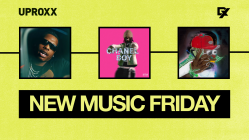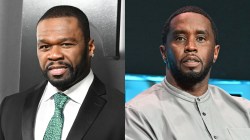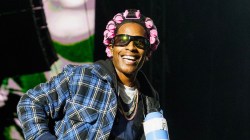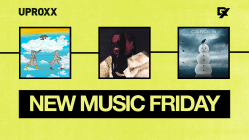Longevity and Hip Hop rarely go hand-in-hand. Remember Mims’ hit? How about the once primetime Crucial Conflict? For most, Rap careers come and go quicker than Twista’s flow, but for a select few, including legendary producer Salaam Remi, Hip Hop is a job for life.
With a volume of work spanning two decades, Remi’s prominence stems from his ability to produce an eclectic variety of beats, which range from the jazzy rhythm of Nas’ “Get Down,” to crossover tracks like Miguel’s “All I Want Is You (featuring J. Cole).” His versatility also made him a close collaborator with the late British singer Amy Winehouse.
Yet unlike many of his peers, Salaam Remi isn’t a household name in Hip Hop, something that the talented beat-maker worries little about. Instead, Remi lets his work speak for itself. His latest solo album, One: In The Chamber, has a list of featured artists impressive enough for any artist, and as Remi will tell you, he still has plenty of thoughts, wisdom and beats for the next generation.
Shortly after the release of his new project, Remi sat down with HipHopDX to discuss the keys to long-term success, his ability to work with a wide variety of artists, and Hip Hop’s continued evolution.
Salaam Remi On How Live Instruments Inform His Musical Tastes
HipHopDX: Judging by all of the instruments in your studio, it’s obvious that you’re not the type of producer to let electronics do all the work for you. Being the son of a musician, how important is it to you to actually play instruments?
Salaam Remi: When I was a kid I played drums, but I didn’t play too much. I took piano lessons and other things that they tell you to do. I never really adapted to it, but I was a child of the Hip Hop generation so I started playing drums, then programming drum machines, then making beats like any other Hip Hop producer would. Then eventually, I would want to play instruments to expand on what I had sampled. That got me to play different types of instruments, because I understood the different sounds; and that got me into engineering more, to figuring out how to sonically get what I wanted as much as musically getting it.
Playing the instrument is part of it, but now sonically knowing how to achieve the feel that you want is a whole other thing. So as far as playing the instruments, I don’t actually have to play it, but I have to know what I want and how to achieve that…if you look at anyone’s phones these days they may have an Alternative record, but they may also have a Pop record [on them]. They may have anything. So for me it’s just a control of sound at this point in my career. Anything I hear I can make it if I choose to. And [I’m comfortable] having a total control of sound from an orchestra to the beats I make on my iPad.
DX: Let’s talk about your latest solo project, One: In The Chamber. Did you use the solo projects of other great producers like Pete Rock or DJ Premier when you went into the lab?
Salaam Remi: Nah. Pete Rock and Premier I consider my contemporaries, especially from a ‘90s era perspective, whereas I was doing records from the late ‘80s all the way into the ‘90s. Pete Rock and Premier definitely pushed the envelope from ‘90-‘95; at that point, that’s what I was looking to become one of the top five as they were—one and two or whatever they were.
But that’s just a small part of my career. In the long scope, I’ve really looked at Lalo Schifrin—who I worked on Rush Hour 3 with—as far as doing orchestral music. He inspired me, along with Monk Higgins—who did groove and bass things I’ve sampled but also had an arrangement thing.
Right now, I’m definitely in a musical arrangement space from the Amy Winehouse productions, the movies I’ve scored and everything else. It’s more than just my Hip Hop influence. My Hip Hop influence is core, and more than even looking at the Pete Rock’s and Premier’s—who were my generations contemporaries—if I’m looking at Hip Hop, I’ll still looking at Marley Marl, who let me co-produce on Craig G’s second album with him, or the Bomb Squad, because I’m still in the ‘80s. The first records I worked on was in the ‘80s, which was before Pete Rock and Premier had records out. I remember seeing DJ Premier at a party with Guru in ‘89, so he might not have been producing yet, he may have still just been a DJ.
So just in that general space—that’s still 24-years-ago—for me, the perspective for my album and for everything that I’m doing is worldwide sounds and productions based upon the works of Quincy Jones, the works of a composer from around the world. But I still do have a Hip Hop generation sensibility. I was still able to do Nas’ “Made You Look.”
But then it’s also based back to even what the Fugees were. The Fugees were as eclectic as they were Hip Hop, with a little bit of Caribbean. I started the journey with them December of 1993 and helped them develop into what they become, and then they want on and to do it themselves. So it’s still consistent for me overall, except now I have even more control of the elements.
How “One: In The Chamber,” Reflects Both Halves Of Salaam Remi’s Career
DX: Many people look at emcees and their lyrics when they think of the crossover element of Hip Hop, but you as a producer have been able to crossover from Hip Hop to compositions and back again.
Salaam Remi: For me there are two sides of it. One is that I really took control of being able to make great instrumental tracks and making beats; that was my ‘80s, my ‘90s. And then from a point on from about 2000 forward, it was really about working with people who had great lyrical capacity and great voices. So that’s the common denominator between Nas, Miguel, Jazmine Sullivan, Amy Winehouse, Lauryn Hill and Wyclef [Jean] of the Fugees. Their lyrics were as important as the tone of their voice, and that’s why they became who they are.
And still at this point for me, knowing that I can manipulate the music from hard beats, to soft strings to whatever it needs to be—from acoustic or electronic—it’s always about the lyrics of a song standing out and those lyrics now hitting you in a way where you get the emotion of a person. And now the music can be wide open in arrangement or full on.
So for “One in the Chamber,” the first song on the album, Akon’s lyrics are more important than the music; the energy of the music is now pushing that story along. But then Jordan Sparks’ “Chocolate Brown Eyes” barely has any music in it for the most part; it’s all about her emotion. So that was my production growth, whereas in it wasn’t just about beat, it was about the song and then the beat, and then how it all came together.
DX: A producer like you doesn’t have much trouble getting an impressive list of features to appear on your songs. One: In The Chamber features Akon, Ne-Yo and Estelle; why did you pick these specific artists?
Salaam Remi: Well those are actually artists I’ve written those songs with, so those are all things that when I was working with Akon I would say, “Hey, do you want to write a couple songs? What’s up with that one? Are you going to put that on your record? Okay, let me get that.” Ne-Yo, we’ve written 15 songs. Okay, a couple were on his last album. [I’d say], “What are you doing with this one? Why don’t you let me get that; I have my strings on that.”
Same thing with Corinne Bailey Rae and Stephen Marley; I just asked him to sing that Beatles song for me because I had the idea, but I knew I wanted a different voice than the typical voice to do it. I was going to do an instrumental first, but then when he did it I was like, “Yeah, this works.” And I was feeling the Reggae grove.
I did the same thing with Estelle; we were writing songs. Just in general—Lemar, CJ [Hilton], everyone on there was just writing songs whether it was for their record or for a project at the time. And then I just pulled it all together to become this record. But I let the songs dictate the choice of them for this record, and I still have half of my next three albums already done, just because I’ve written songs with so many people.
But for me, what I wanted to do was to create the experience for people who just like great music. And it’s for people who like music that sits in a certain pocket that’s not necessarily simply commercial, but it’s beautiful music that hits you in a beautiful way. You can listen to it and go, “Wow, that was a beautiful experience.” So for me, the whole orchestral space of still doing something that’s jazzy in a groove; it’s about actually being able to enjoy and then going, “Okay, why?” So we’d just end up going places, like The Blue Note on a Saturday night. Well consider my album The Blue Note on a Saturday night. If you do it once a month, it feels right, then you go back to get that total experience and those lyrics. It’s not always about what’s happening on 42nd street.
Salaam Remi Explains Taking Cues From Concord & Blue Note Records
DX: As you said, you worked with Bob Marley’s son Stephen Marley on this record. It seems like there were plenty of musical influences and shoutouts – such as the track “Eleanor Rigby.” Who or what were some of the other influences for this record, and why did you choose to throw in musical shoutouts?
Salaam Remi: Being a child of the Hip Hop generation allows me to have poetic license. So when I think about Nice & Smooth’s “Sometimes I Rhyme Slow,” taking the acoustic Tracy Chapman and turning it up so that when he says, “I was on 125 and St. Nick,” we would always take those elements and make it back into what we wanted it to be. I worked on a lot of movies recently, so just like with the movies, I might be sitting in this room. And if we put on a very acoustic song, then it’s one mood, but we could put something that’s rambunctious and lovable to the same scene.
So the way I look at the “Eleanor Rigby” is during my first experimentation improv, I was just simply recording. I said, “You know what? I have an idea, let’s do this with the upbeats. Wow this is different.” And I was just testing it to see if I could have that laid out with this orchestra in front of me. And then as far as saying, “Hey, this would be a good juxtaposition to have Stephen Marley sing it.” It was just, once again, Stephen and I being close friends. Stephen lives right around the corner from me in Miami, so it was like “Hey yo, try this.” And he was like, “Yeah, I love that song!” So he tried it, it felt right and I was able to flip the arrangement and put a bass on it and kind of give it a groove.
I love doing things like that in general, because it is Hip Hop as far as the Hip Hop generation. But I also think if the youth culture right now… If they have an iPod, they’ll have The Beatles and Bob Marley in there, so you give them a bridge.
DX: The album is kind of like a movie soundtrack itself. You have high notes, more somber parts and very jazzy sections. It’s not as cohesive as some projects.
Salaam Remi: I’d say it’s cohesive, but the other things are more monotonous and one-zone, so it’s a day in the life. It’s uptown, downtown, midtown; it’s just a continuous flow in that way. But once again, my world and my career spans all of it. It’s my album. If it was one of those artist’s albums they may not go so far, but since it’s my album it was a little bit of all of that. I didn’t even really touch the Hip Hop side of it, but now I have room for that on the next one and the one after that.
I didn’t even really work with most of my constant collaborators on this one—which would be Nas, Miguel and Jazmine Sullivan—but they’re working on their albums now. We have music, and things are going to continue to come out, but I’m opening the stage for that, and for my label Flying Buddha. It’s really just based upon being like a Concord or a Blue Note Records musically, but for a youth generation like a Downtown or XL Records.
Salaam Remi Reflects On Past Work With Nas & J. Cole
DX: You’ve been with Nas from God’s Son all the way through to Life Is Good. What’s it like working with an artist as their career progresses?
Salaam Remi: We’re both growing, so our perspective on stuff is kind of similar, because we have similar backgrounds. So we enjoy some of the same parts of life, although he has a different path: he’s been married, not married; kids—I have no kids, and I’m not married. And it’s gone from, “Wow, I’m about to be 30,” to, “Wow, I’m about to be 40.” So it’s all a laugh, but once at the core, we’re both sons of musicians who know a lot of different music—a lot of different Hip Hop and R&B, so we just find ways to express it.
It’s a growth process, but still understanding how urgent it can be. I think with Nas and my collaborations they still sound as urgent as the 17-year-old versions of us would’ve made it. And that’s kind of what I try to stick to. When I make Hip Hop, I want to make Hip Hop that slaps you in the head. But that’s just the Hip Hop I love. Other people grow into different things; that’s just for me, but if I’m going there, that’s what I like to do.
DX: When I think of “Get Down,” I think of it as less slapping me in the head and more of a jazzy track with the horn fanfares and quips…
Salaam Remi: Well that was his idea. The day we made “Get Down,” number one: As a producer, I wouldn’t have sampled that James Brown thing in 2002. I wasn’t thinking about it, but he was like, “Hey, I want to rhyme off of that. Can you loop that for me?” So I went to Colony Records on 49th and Broadway, bought the CD, threw it in, looped it for him.
DX: Just like that, during the middle of a recording session?
Salaam Remi: Yeah, at the time we were working on 48th and Broadway around the corner. So I went to the store and bought the CD with the Black Caesar soundtrack. I looped it, and he was like, “Okay, sample the ‘Get Down.’” Nas was a producer on that record. So he did it, and then he was having a F.E.D.S. magazine interview. He was talking about different things like Pistol Pete and watching somebody from his neighborhood called Three Eye that grabbed a court officers gun. He sat down, he listened, 20 minutes with the pen, [and said], “Alright, let me go in.” Boom, he spits the whole first verse like, “Yeah, I’m on some Biggie shit.”
“New York streets where killers walk like Pistol Pete,” using every three word rhymes like Big would, spit it all out, and at the end of that was like, “Now throw the ‘Get Downs’ in.” So I threw the horns in, threw the ‘Get Downs’ in. When the second verse came up, I switched up the beat and played around with the productions, but it was his idea. And that’s what I do: I allow artists to be themselves and have an idea, and I help them complete it.
DX: You did the outro of that song, right? – “If that’s how our people gonna get down, how we ever gonna get up? How we ever gonna get up if that’s how we get down?”
Salaam Remi: That actually is my voice; that’s me. I was talking into the piano, and I was imitating my grandfather. Once I played the piano on the end of it, added some beat bars to it… That’s the beauty and inspiration of it. I just told the engineer, Kevin Crouse to record the piano mics, and I just talked into it imitating my grandfather’s voice into the piano. I didn’t even think about it, I just said it.
DX: So that was off the top then? It was a freestyle?
Salaam Remi: I can freestyle pretty good. I usually come up with an idea in the moment. But freestyle in terms of lyrics, I usually just let the artists do what they do. But I’m pretty spontaneous.
DX: You’ve been producing since Hip Hop’s Golden Age. How have you adapted over time to stay at the forefront of the evolution of Hip Hop? How do you go from ‘90s artists like Da Bush Babees to J. Cole?
Salaam Remi: I think it’s all consistent for me. But I think that, in general, my principles pretty much say the same: sit down and work on a beat. I kind of just vibe with people. If we’re about to have good conversations, then that conversations usually transfers into good music. Sometimes I just spend the session listening to music, like, “Hey, what do you think about this? Play me your favorite songs.” So we’ll sit down and listen to the stuff, and as it’s playing I’ll grab the instrumental, turn it into something and we’ll just vibe, talk and let their creativity spawn.?
I’ve dealt with artists that are at a great point in their career; I’ve dealt with artists that are at a down point in their career – some rich, some poor. I’ve had great success with artists at the beginning of their career, helping them look at their process a little bit differently. Like with J. Cole and the sessions I had with him. He wrote “Who Dat” to the track that I was doing with him, and then put the rhymes back together on his own beat. I just like to inspire them. I’ll inspire them, and then they’ll inspire me, and we share this inspiration. And if we record it properly we can inspire others.
Why Salaam Remi Feels Regional Listener’s Perspectives Have Changed
DX: What’s your take on the state of Hip Hop today?
Salaam Remi: Everything is different. When it comes down to it, Hip Hop is still the same to me, it’s just a venue. Right now, the music that we hear is based upon the venues that are open. The music in the ‘80s was based upon the Latin Quarters and the energy of the Latin Quarters. So what the people in Manhattan wanted to hear, what went into that venue and how they felt when they were told to throw their hands up—because that music was there and there was somebody talking—then that’s what happened.
When you look at the venue now becoming the strip clubs, because New York’s clubs were closed by the Hip Hop police several years ago, and there was nowhere for it to incubate. So even in New York, if you’re asking where people really are, they’re in Perfection or they’re in Sue’s Rendezvous. They’re in all these particular strip clubs.
And then in the South—where music was allowed to incubate before it was allowed a label or a radio station or anybody else—yeah you’ve got a banging beat playing. You’ve got a girl making a guy’s lap happy, she’s walking away with some money and there’s drinks flowing. Oh, this is a party! So people are going to be in there every day, and there’s going to be a song playing. And then lyrically, the people that are at the top of that space… There will be people that will be in there on a fluke, but at the end of the day—line for line for Rick Ross, for Lil Wayne, for Drake—you can’t stop them! Because their lines, metaphors and the ways they’re describing their overall experiences is the same. Is Milk D really that much different from Meek Mill’s “I’m a Boss”? A well put together beat in a space is something that I’m going to catch line for line, and it’s got that energy that’s going to make somebody that’s sitting down want to get up and throw their hands.
So I think that the energy of Hip Hop… The only thing that’s changed is the perspective of certain people wanting to hear other sounds that aren’t relevant right now. But they’re not relevant because there’s no venue for them to be played in. And that will slowly change over time.
DX: I spoke with a rapper from Atlanta recently who told me the same thing—that Hip Hop in the South is so prevalent in strip clubs because that’s where it incubates.
Salaam Remi: Where it has no filter. There’s no one saying that that can’t be it. And once you have someone telling you that you can’t be doing something because it’s not cool, then you lose.
Salaam Remi Details His Work As A Music Supervisor & Composer
DX: I wanted to personally thank you for the soundtrack of Office Space. When I think of that movie, the signature moments are all made better by the memorable songs they’re paired with, something you were partially responsible for. Are there any similarities between deejaying and picking tracks for a movie?
Salaam Remi: Just like how it’s always about the lyrics first, it’s always about the movie first. So in saying that, I can never think that I’m going to put a song in the scene that’s going to overpower the director’s vision for the scene—the dialogue, the mood, what’s being said and how it’s being received. So it’s always about that first, and I think that’s the biggest thing. As long as we’re able to achieve what is making the story and what moves the story along, then that’s when the song’s really working. Being able to find songs that do that or being able to score something that underlies what’s happening is the biggest thing. If you have something that goes against the grain then the movie’s wack; the music’s not making it.
DX: How do you go through your music library and find that one track that fits just right for a certain scene?
Salaam Remi: Watching the scene, looking through stuff and writing stuff. There’s an art to it as well. Great music supervisors are someone you can take your hat off to, because they’re able to look at it and have great ideas for different spaces. Different people will perceive things in different ways, but a lot of directors have a lot of ideas on what they’re feeling and what they’re trying to get out of something, like Quentin Tarantino. He knows what music he wants for a scene before he even shoots.
But once again, as a music supervisor or composer, your job is to work with the director as an artist—just having communication with them. Knowing that they’re looking for something from you and being able to deliver; [the director] being able to express that to you and you being able to find a space for it.
DX: Just like your productions, you’ve worked on a wide range of soundtracks from Zoolander to The Departed, movies that require you to branch out from your Hip Hop roots. What does this say about your taste in music?
Salaam Remi: I mean with The Departed, Zoolander and Office Space—I did one song for Office Space called “Shove This Jay-Oh-Bee,” which Mike Judge wanted to end it. Zoolander and The Departed have songs that I’ve produced that were put into it. But with Sparkle, I actually scored it; with the [Mike] Tyson documentary I actually put the music into it. With Rush Hour 3 and Sex And The City, I actually worked with the director and the creative team to write songs that were written for the movie the way the director wanted it. So with those I was more hands on in terms of creating the dynamic of it.
I’ve done many songs for end titles alone, like for Gnomeo & Juliet and Blood Diamond. But when it comes down to Sex And The City and Rush Hour 3, I actually worked from script to screen through that whole process. It’s something that I attacked in 2004 and said, “Hey, this is something I want to learn how to do,” and worked on it. I got a place in L.A., sat down in every meeting and really applied myself to it, because I didn’t just want to show up and say I did my part. I’ll be here at every meeting, I’ll be here before every meeting and I want to see what’s going on. That was my option, and that was what I decided to do. That’s my way of getting it done.
DX: What other forms of modern music have been most influential for you?
Salaam Remi: A lot of stuff is older music. I listened to a lot of Jazz over the past year. When I was younger I listened to a lot of Jazz, because that’s how we were producing. I listen to things that expand my mind. Chord change-wise and noticing where things are, and then when I’m doing a commercial record, those influences now will come back in with me…but a lot of times it’s just a lot of Jazz and Orchestral stuff—things that sound like my album.
That Corinne Bailey Rae record [“Makin’ It Hard For Me”], really. On that record I’m playing piano, bass and drums. I feel myself on that record…the way it’s approached. Corinne’s playing the guitar, and we were able to get into a great place, and then I added the orchestra to take it to a whole other cinematic level. But the core is just what I feel from all of my different influences.
DX: You recently started your own label, Louder Than Life, under Sony Music. You’re also the VP and doing A&R work at Sony Entertainment. What’s it like going from the artist side of things to the corporate side of things?
Salaam Remi says, “The Content Is More Important Than Me.”
Salaam Remi: It’s great. Right now under Louder Than Life I have two different labels that are also my boutique labels. So my album’s on Flying Buddha Records, which is more jazzy in content but marketed right at youth culture. I also have Hiatus Kaiyote, so that’s going great. My other label Re Mi Fa Music, has Mack Wilds, is ‘90s Hip Hop.
I really feel proud of the music and the artists that I’m working with, and I see great potential for them in the future, which is what I want to be a part of—long illustrious careers of people who will make a difference for themselves and the generation.
As far as me going into the exec space, it’s kind of something I’ve always done without really doing it, so there was never an A&R that came to a Fugees session. Ever. And the same thing with Amy Winehouse. Some people do it, but for me, my influence with the artist, we just work together developing what we wanted to do. And even working on the films. I was working as executive music producer on the films, so with my relationships it’s all just positive space.
So right now, for me as an exec it’s great, because I have great relationships with most of the execs that I work with after working with them in different capacities for so long. And also with the creative community, just being able to talk to somebody about a song and they can tell me something but I can also say, “Hey, that’s a good idea.” A lot of times creative people forget how good they are, and they need someone to remind them.
DX: How do you help an artist improve, and in some cases build upon their past in order to help their career?
Salaam Remi: Just conversations. Asking them what they like and what they’re aspiring to be and then seeing how I can make that happen.
DX: Even though you’re at or above the level of all of today’s household name producers, your name still isn’t widely recognized to the casual music fan. Why is that, and is it something you prefer?
Salaam Remi: Yes, totally. Number one: I’ve never been an artist. So when you think about DJ Premier of Gang Starr and Pete Rock of Pete Rock & C.L. Smooth, they’ve always made albums and kind of sat behind that. I’m not one to necessarily talk and tag my records. It’s always been about the artist I was working with. I’ve always stood behind that, and that’s just my personality and also something that I feel that the true creators have done over time. They didn’t try to take credit before you ever knew that it happened. For people that look into it, I’m happy if they’re saying, “Hey, I’m looking forward to your productions,” but always understand the content is more important than me.
RELATED: Salaam Remi: Made You Listen










thank u HHDX for that great interview, which sadly few would read.
It was too long & who the fuck is dis nigga?
@above comment. A great producer. Learn you something instead of writing him off
Maybe if you read it you would know…
uptil I looked at the paycheck which had said $4571, I didn’t believe that…my… mother in law woz like realie earning money part-time from there computar.. there friends cousin haz done this 4 only about 1 year and resantly repaid the morgage on their home and got themselves a Buick. this website http://smarturl.it/pg1cfz
Interviews are the best thing about this site. Great one as always.
Thank you for this one, HipHopDX. Great interview with great artist! This man is mad talented. Wish him all the best.
This guy does not look his age at all.
true story
wow. long interview! tried my best to scan through though
this nigga handled the majority of production on “Life is Good”…..and that album sucked ass….
no ,you sucked ass
damn Med, are you getting points off the album?….its just an opinion, douche……when you use a comma in a sentence, there is no space before said comma, though the comma should be followed a space…….dickshit…
Great interview-DX, salute. Salaam Remy is a legend in his own right, didn’t sound stupid or dumb for the sake of being seen as ‘hood’.
Peace
Easily one of the most underrated producers for the last 20 years. Great interview!
dope article. didn’t know he was around from that long, definitely underrated
read the whole thaaang…. *crazy*
We need you help hip hop fans. Serious. Below is a link to petition for the release of Dr. Dres Detox album. Only takes 10 seconds to sign. Help us send a message to Dre. Post the below link everywhere like facebook, reddit, hip hop blogs etc.
http://www.petitions24.com/hip_hop_fans_for_the_release_of_detox
Salaam Remi is the living proof for a hit or miss producer. He could be one of the greatest ever if it wasn’t for his wavering and scattered work. In my opinion, that’s his personal tragedy when it comes to career and legacy.
There are producers who made a name for themselves by upholding a high quality level for a long time, so while it cost an arm and a leg to work with them, the result rarely disappointing. Just take a look at Scott Storch or Timbaland in the mid-2k’s, literally 9 tracks out of 10 they touched turned out incredible dope. Same goes for Kanye West or Just Blaze in that era. Dr. Dre used to be a synonym of perfectionism for two decades, and there were times when Swizz Beatz made A+ beats constantly.
Going further, there are producers who only hyped for a minute thanks to a recent hit or just because their beats stylistically sounds like what considered hot in their days. They eventually fade to black, maybe the best ones can have some longevity for a while.
And we have Salaam Remi. His discography is absolutely confusing and serves as a testimony for two things: first, it’s undeniable that the dude has talent; and second, we still don’t know how he dope REALLY is.
Think about it.
Seems like he has mad chemistry with certain artists (like NaS or Amy Winehouse), to whom he’s capable of bringing his A-game to the table. On the flip side of the coin, these masterpieces are completely overshadowing his efforts with other people, providing more questions than answers for us. Sometimes his tracks really hit rock bottom, and makes you wondering that maybe Salaam is more lucky than gifted.
Basically the pattern is straightforward: he came up with 1 phenomenal piece of work what makes you keep coming back for more, then his next 3 track simply nowhere near that level while the 5th one are so immensely cheap and uninteresting that you give up the hope. And that’s when he’s dropping another fantastic song, thus restarting the whole process.
Overall, I’m afraid the only way to find out about his real potential would be to listen all unreleased tracks from his sessions with Nas or Amy Winehouse – therefore we can answer if their hits were the result of genuinely talented people bringing the best in each other, or merely the rare exceptions of hundreds of work hours.
Agreed
I think he’s as consistent as Alchemist at least.
I think timbo is better and more consistent, but not every timbo beat is stellar either
its nuts how that was salaam on get down. i thought that was a sample
I am gonna be honest, i only know this cat because of his association with the King of NY, Nas. Outside of that, i dont know any of his work.
There is a reason why producers such as Dilla, Madlib, Pete Rock and Premo are considered to be amongst the Top 10 of all time. I will take 2 of the aforementioned as examples to illustrate my point.
Dilla – Arguably his best work was with the relatively unknown emcees, Baatin and T3. None of them were the best spitters in the game or anything, but due to his production, we got to know about this group. Dilla did not need to work with a big rap superstar to gain recognition, he made emcees look good. Busta’s best tracks were produced by Dilla, Common can attest to that.
Madlib – What do we know about Madlib, he is the most prolific hip hop producer ever. Freddie Gibbs is probably the 1st mainstream artist he has had to work with, yet he commands the respect from artists such as Kanye.
Pete Rock – CL Smooth was a good emcee, but not one of the best, yet the due of PR an CL made some of the best work of the 90’s.
In a nutshell, there are producers these days such as Symbolic 1, Hit-Boy, Boi-1-da, Salaam Remi etc, whose only claim to fame is working with famous artists and releasing records that managed to sell. S1’s twitter profile still mentions Kanye West’s ‘Power’ record.
Sorry yo, but CL Smooth was/is an exceptional lyricst with or without PR
Let’s keep it real, he stole that beat from Lord Finesse’s “Bad Motha”.
Its virtually the exact same beat with the exact same sample.